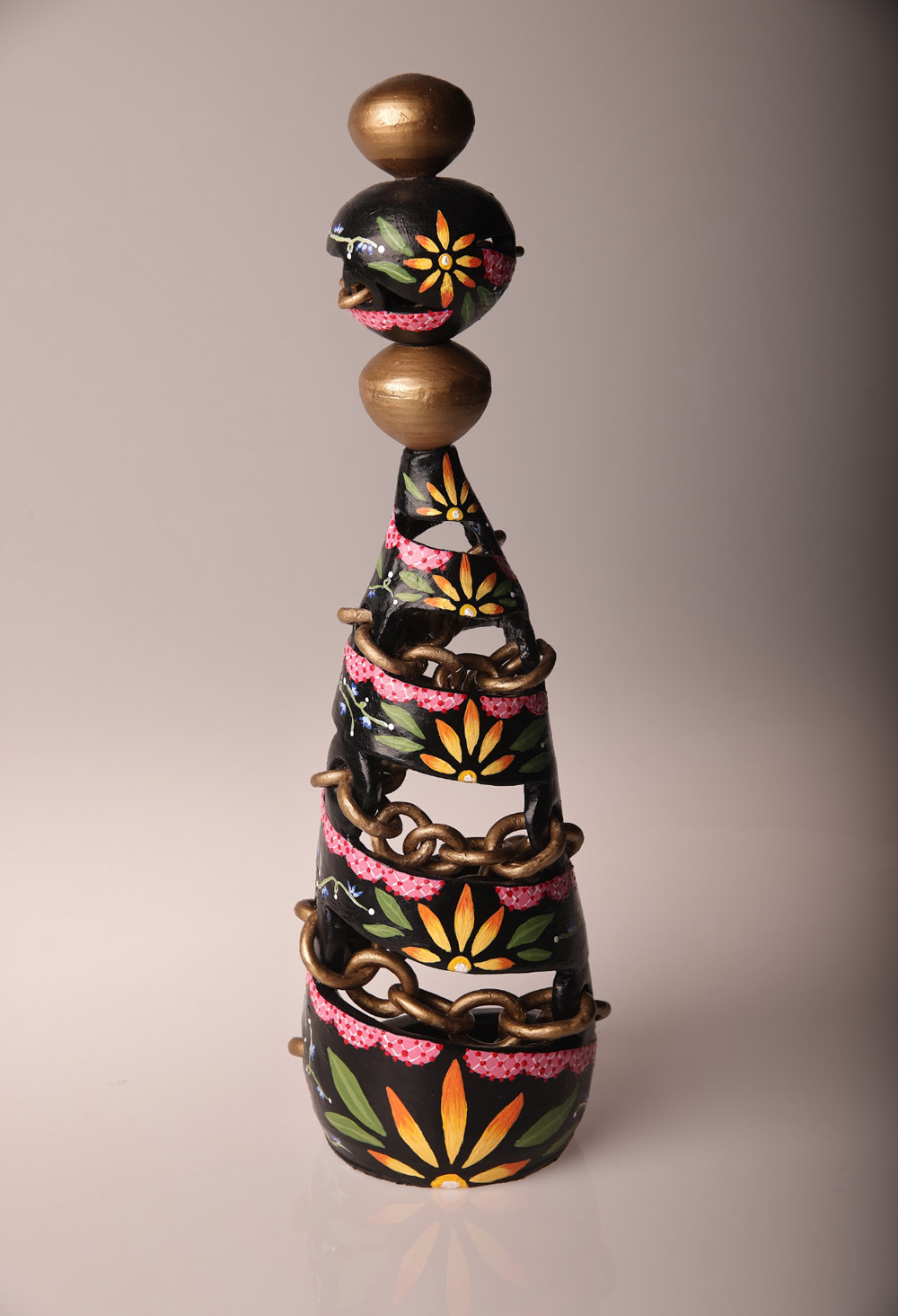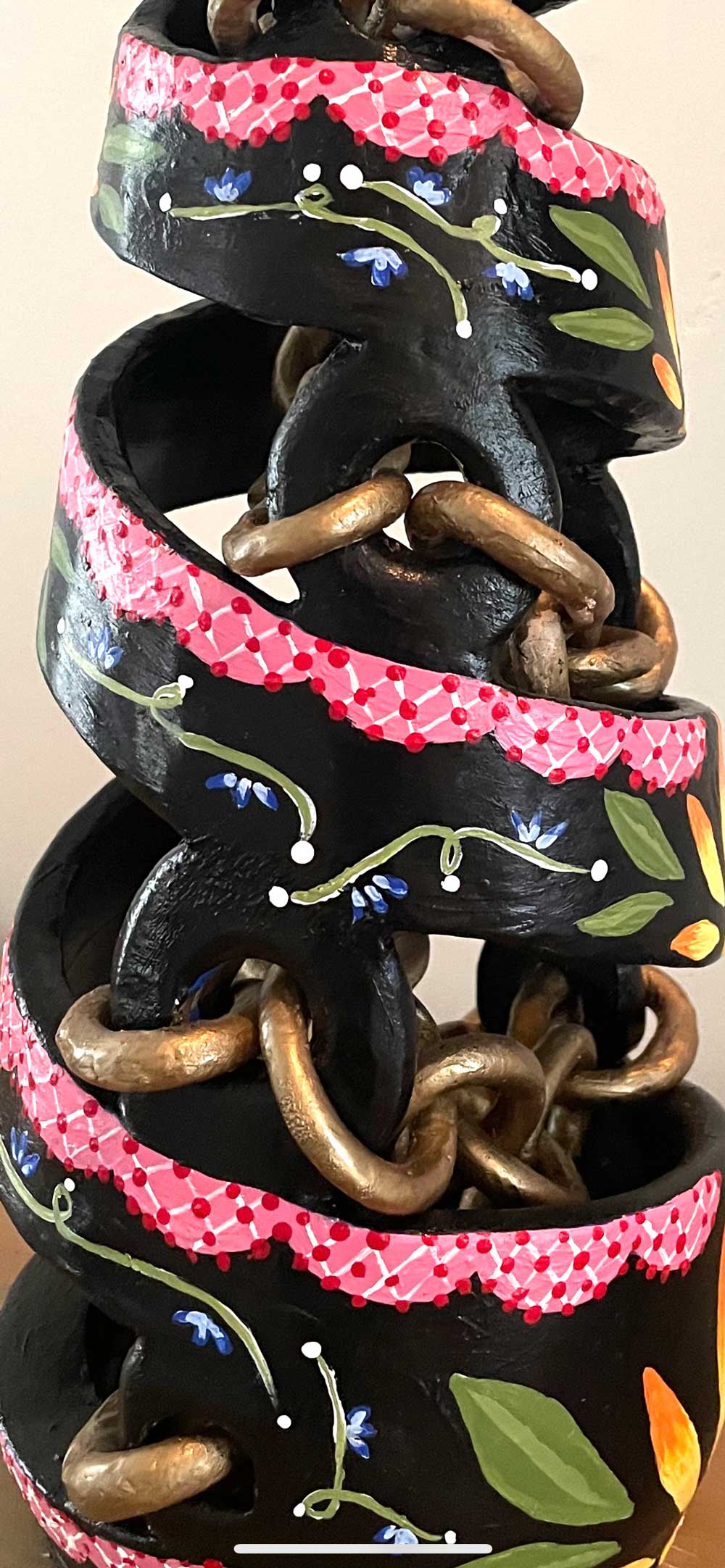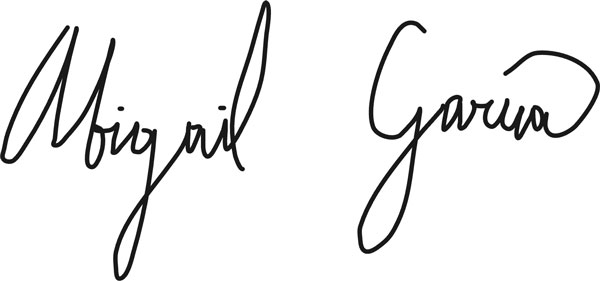

La Falda

Height: 20” x Width: 7” x Depth: 7” | Material(s): B-mix clay, acrylic paint | Process(es): Wheel-thrown vessels separately. Carved out intricate design. Stacked them, painted cultural design. | Citation(s): Personal imagination and references. | Idea(s): My portfolio conveys the mental struggle of balancing my cultural identity by physically creating ceramic pieces using various methods of balancing, chain work, etc., to show how I explored my cultural identity. Not knowing where I fit within my two cultures, two countries, two people was hard for me to understand. | Curatorial Note: In this artwork, the student makes good use of negative space and visual as well as physical balance. The use of gold chains in the open spaces and the vibrant colors against the black background throughout the piece resonates effectively with the artist’s aim to portray their cultural identity.
Abigail Garcia
Student statement
Student statement
Does your work reference or draw on a contemporary or historical art-making style, practice, or tradition? If so, please explain.
My piece is inspired by traditional Mexican pottery. I incorporate similar floral patterns and shapes into my surface designs.
Please describe the context for how the idea for this artwork originated (was this part of your sustained investigation, an independent project, a class assignment, created during a summer study, etc.).
At first, it was challenging to find a theme, question, or idea for my sustained investigation. I worried that writing about my culture and experiences might be too common and lack uniqueness. However, my perspective shifted when I realized how much I value hearing voices similar to mine. While not every Latina's experience is the same, I recognized that creating art about my own journey could resonate with someone and contribute to their sense of belonging. Originally, my concept for my sustained investigation focused solely on balancing ceramic spheres and exploring how my Latin culture influences my life. However, as I progressed, I began to learn more about the challenges my mom faced during her immigration journey and how she adapted to life in America. One constant in her life—and mine—has always been Latin music and dance. With this newfound understanding, I wanted to push myself as an artist by creating the most intricate piece possible, combining my passion for spheres and chains. I also challenged myself to design an abstract figure that represented everything I had learned. That’s when the idea struck me: I wanted to create an abstract figure inspired by women in "Folklórico," a traditional Mexican dance.
In what ways did you practice and experiment when developing your sustained investigation?
The experimentation in this piece is seen in the process of balancing the small spheres on top of each other. My original idea involved positioning a wire or wooden dowel down the center for support. However, I realized these elements might distract the viewer from the overall piece. Instead, I experimented with various other methods and finally settled with the approach of creating small dents in the spheres, allowing them to fit perfectly on top of each other. I secured their structure with glue, ultimately achieving a balanced and cohesive figure of spheres.

I researched controversial topics of the Latinx community and took them as inspiration.
How did you demonstrate revision in your sustained investigation?
The creation of this piece involved extensive revision at every stage—from planning to creation and even the final touches. I faced 15 failed attempts at crafting the vessel, but each failure taught me new wheel-throwing techniques and helped me refine my approach. Midway through, I took a bold risk and completely reimagined my surface design, choosing to carve into the ceramic sculpture instead. To add depth and meaning, I spontaneously incorporated chains to create texture and evoke a sense of juxtaposition—symbolizing both the connection culture brings and the limitations customs can impose. This adjustment required five more attempts to perfect. In the end, the piece came together beautifully, but only through patience, determination, and constant revision.
How did your art teacher support your artistic development?
I had two of the most amazing art teachers! Mrs. Seamons, my AP art teacher, and Mrs. Anderson, my ceramic teacher. I truly consider them my mentors. They have helped me during the entire process. From pushing my limits of what I could create to pushing me out of my comfort zone of what I could imagine. Their encouragement and feedback have helped me grow tremendously as an art student. While I still have much to learn as an artist and creator, their mentorship has instilled in me the qualities of patience, confidence, and humility.

Detail | Material(s): B-mix clay, acrylic paint
Process(es): Wheel-thrown vessels separately. Carved out intricate design. Stacked them, painted cultural design. | Citation(s): Personal imagination and references | Idea(s): Abstract figure with a “falda” (skirt)
What is your advice to other AP Art and Design students?
Whatever your idea is, whatever you’re thinking of creating—do it! Don’t let fear hold you back from what could become your greatest achievement. I’ve learned that confidence plays a crucial role in the development of your art. Advocate for yourself and your ideas, and trust in your creative vision. At the same time, always remember the importance of humility. Admire other artists, learn from their skills, and embrace the process of growth—including the failures. I truly believe that when an artist combines confidence with humility, they can master their craft and create something truly extraordinary.
Kaitlyn Seamons
Lehi High School, Lehi, Utah, USA
Teacher statement
Teacher statement
The AP Art and Design course supports inquiry-based personalized learning in the sustained investigation portfolio component. What strategies helped you guide students through inquiry?
They begin in the summer with brainstorming and exploring several big ideas, guided by a questionnaire. At the beginning of the school year, they narrow these big ideas down and explore them in mini one-day projects, which they analyze and use to select their most meaningful and interesting inquiry seed(s). Abby explored her ideas throughout her high school career, in both 2D and 3D forms, but it wasn’t until this past year (as a senior) that she tied her cultural heritage into the innovative and stunning work you see in this exhibit. All of that experimentation built her capacity to conceptualize an idea and use her advanced technical skill to carry her deeper message.
How did you support skill development AND inquiry in the AP Art and Design curriculum?
The students are asked to keep an art journal throughout the year in which they practice and plan their work. This journal is also required to show specific skill development based on the student’s goals for the term/year. They are required to practice for at least 10 hours per term outside of class and connect it to their portfolio of work. The students can get additional resources and one-on-one help with techniques, but we primarily focus on inquiry in class. The skill component is heavily scaffolded in Honors Art, which they take the year before entering AP, so that they can focus on the inquiry during their AP year. Additionally, Abby voluntarily audited or TA’d for art classes to give herself more studio time, which led her to some of her most successful technical and creative innovations.
How do you support your students in the Selected Works portfolio component?
Midway through the year we have a whole-class critique where students get feedback on their inquiry as a whole, but also which pieces best demonstrate the skill and intent of the artist. As we approach the test, students narrow down their top choices for the selected works section and get feedback from their peers and myself in choosing their best works for submission.
Process
What creative programming (i.e., exhibit spaces, mentoring programs, curricular supports) have you implemented to support AP Art and Design students?
I grade based on the students’ own goals, and they track their progress and develop greater time management through regular check-ins. I also take the AP students on Art Tour to Los Angeles to explore a wide variety of art styles and methodologies in art making, hoping that it inspires their own practice and helps them see what possibilities they want to explore in their own work. One of the most impactful strategies the students and I developed last year was an in-depth small group critique every two weeks that allowed them to get feedback both mid process and on their overarching inquiry through peer review.
What did you learn from working with your student?
Abby is an incredibly kind and intelligent young woman, and as she worked with me and her ceramics teacher Marjorie Anderson to develop a technically and conceptually strong inquiry, I saw the power of an artist connecting with her own legacy. Abby put so much research and personal experience into her work, and I was honored to see her grow and develop as an artist and storyteller through AP. My biggest takeaway from working with Abby was to just let the students find their voice through encouraging their passion projects. Abby was so excited about exploring her cultural heritage that her quality and personal voice naturally came through in the artwork.
Tim Brantley
Principal
Lehi High School, Lehi, UT, USA
Leader Statement
Leader Statement
What are you most proud of regarding your school’s AP Art and Design program, student, and teacher?
I am most proud of our AP Art and Design program's ability to foster a creative environment where students are encouraged to explore their artistic potential and develop their unique voices. Our students consistently produce exceptional portfolios, showcasing not only their technical skills but also their innovative thinking and cultural awareness. This success is largely due to our dedicated teachers, who provide individualized mentorship and integrate real-world artistic practices into their curriculum. This approach not only prepares students for further education and careers in the arts, but also cultivates lifelong appreciation and passion for creativity.
What do you do to support visual arts programming in your school?
To support visual arts programming in our school, we ensure that students have access to quality teachers, materials, and spaces for creativity. We also provide professional development opportunities for teachers to explore innovative teaching methods and integrate technology into their lessons. Collaborating with other teachers and local artists is extremely helpful.
What is your advice to other school leaders on how to support an AP Art and Design program?
To support an AP Art and Design program effectively, prioritizing the hiring of passionate and knowledgeable teachers is foundational. Teachers must foster an environment that encourages creativity and experimentation. Also, engagement with local artists builds connections and excites students about possibilities. Finally, showcasing student work celebrating achievement is critical.

Abigail Garcia



